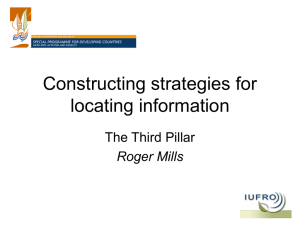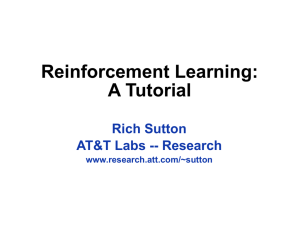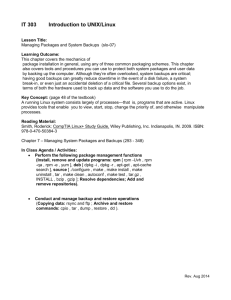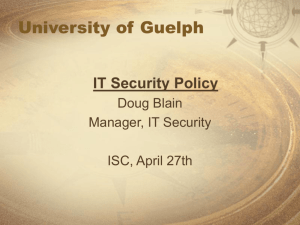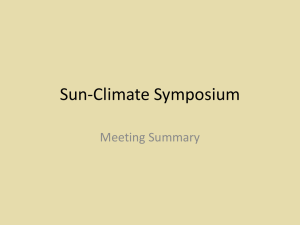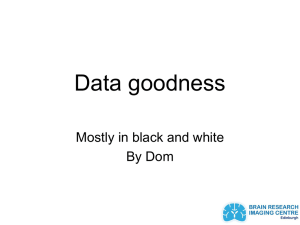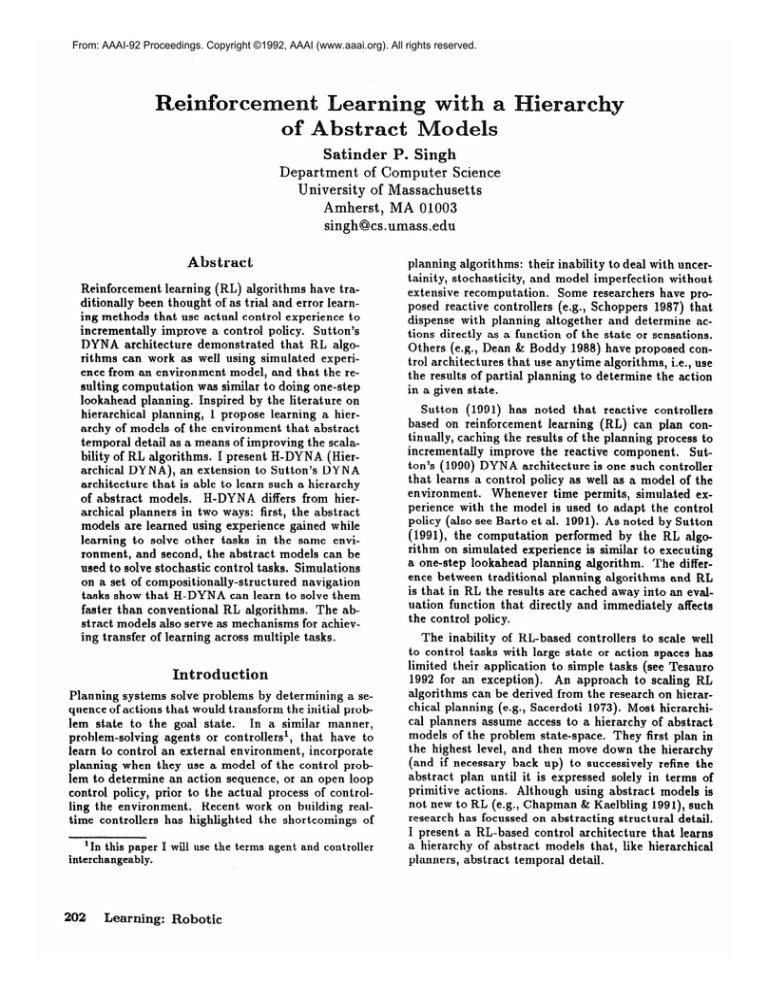
From: AAAI-92 Proceedings. Copyright ©1992, AAAI (www.aaai.org). All rights reserved.
Satinder P. Singh
Department of Computer Science
University of Massachusetts
Amherst, MA 01003
singh@cs.umass.edu
Abstract
Reinforcement learning (RL) algorithms have traditionally been thought of as trial and error learning methods that use actual control experience to
incrementally
improve a control policy. Sutton’s
DYNA architecture demonstrated
that RL algorithms can work as well using simulated experience from an environment model, and that the resulting computation
was similar to doing one-step
lookahead planning. Inspired by the literature on
hierarchical planning, I propose learning a hierarchy of models of the environment that abstract
temporal detail as a means of improving the scalability of RL algorithms. I present H-DYNA (Hierarchical DY NA), an extension to Sutton’s DYNA
architecture that is able to learn such a hierarchy
H-DYNA
differs from hierof abstract models.
archical planners in two ways: first, the abstract
models are learned using experience gained while
learning to solve other tasks in the same environment, and second, the abstract models can be
used to solve stochastic control tasks. Simulations
on a set of compositionally-structured
navigation
tasks show that H-DYNA can learn to solve them
faster than conventional RL algorithms.
The abstract models also serve as mechanisms for achieving transfer of learning across multiple tasks.
Introduction
Planning systems solve problems by determining a sequence of actions that would transform the initial problem state to the goal state.
In a similar manner,
problem-solving
agents or controllers’,
that have to
learn to control an external environment, incorporate
planning when they use a model of the control problem to determine an action sequence, or an open loop
control policy, prior to the act&
process of controlRecent work on building realling the environment.
time controllers has highlighted the shortcomings
of
‘In this paper I will use the terms
interchangeably.
202
Learning:
Robotic
agent
and controller
planning algorithms: their inability to deal with uncertainity, stochasticity,
and model imperfection
without
extensive recomputation.
Some researchers have proposed reactive controllers (e.g., Schoppers 1987) that
dispense with planning altogether and determine actions directly as a function of the state or sensations.
Others (e.g., Dean & Boddy 1988) have proposed control architectures that use anytime algorithms, i.e., use
the results of partial planning to determine the action
in a given state.
Sutton (1991) has noted that reactive controllers
based on reinforcement
learning (RL) can plan continually, caching the results of the planning process to
incrementally
improve the reactive component.
Sutton’s (1990) DYNA architecture is one such controller
that learns a control policy as well as a model of the
environment.
Whenever time permits, simulated experience with the model is used to adapt the control
policy (also see Barto et al. 1991). As noted by Sutton
(1991), the computation
performed by the RL algorithm on simulated experience is similar to executing
a one-step lookahead planning algorithm.
The difference between traditional planning algorithms and RL
is that in RL the results are cached away into an evaluation function that directly and immediately
affects
the control policy.
The inability of RL-based controllers to scale well
to control tasks with large state or action spaces has
limited their application to simple tasks (see Tesauro
1992 for an exception).
An approach to scaling RL
algorithms can be derived from the research on hierarchical planning (e.g., Sacerdoti 1973). Most hierarchical planners assume access to a hierarchy of abstract
models of the problem state-space.
They first plan in
the highest level, and then move down the hierarchy
(and if necessary back up) to successively refine the
abstract plan until it is expressed solely in terms of
primitive actions.
Although using abstract models is
not new to RL (e.g., Chapman & Kaelbling 1991), such
research has focussed on abstracting structural detail.
I present a RL-based control architecture that learns
a hierarchy of abstract models that, like hierarchical
planners, abstract temporal detail.
einfbrcernent
Learning
Algorithm!
Unlike planning-based
controllers,
RL-based
controllers are embedded in an optimal control framework
(Barto et al. 1990). Th us, the RL agent has to learn a
sequence of actions that not only transforms an external dynamic environment to a desired goal state2, but
also improves performance with respect to an objective
function. Let S be the set of states of the environment
and Al be the set of primitive actions3 available to the
agent in each state. In this paper, I focus on RL agents
that have to learn to solve Markovian Decision Tasks
(MDTs), where at each time step t the agent observes
the state of the environment,
Q, and executes an action, at. As a result, the agent receives payoff Rt and
the state of the environment changes to st+l with probability Et,,,+, (at). Th e o bj‘ec t ive function, J, considered in this paper is the discounted sum of payoff over
Y’Rt.
The disan infinite horizon, i.e., J(i) = ~~~~
count factor, 0 5 y 5 1 causes immediate payoffs to
be weighted more than future payoffs. A closed loop
control policy, which is a function assigning actions to
states, that maximizes the agents objective function is
an optimal control policy.
If a model of the environment is available, i.e., the
transition probabilities
and the payoff function are
known, conventional dynamic programming (DP) algorithms (e.g., Ross 1983) can be used to find an optimal
policy. If a model of the environment is not available to
the agent, RL algorithms that approximate DP, such as
Sutton’s (1988) temporal differences (TD), can be used
to approximate an optimal policy. An essential component of all DP-based algorithms4 for solving MDTs
is determining an optimal value function V* : S -+ 3,
that maps states to scalar values such that in each state
the actions that are greedy with respect to V* are optimal. DP-based RL algorithms use repeated experience
at controlling the environment to incrementally update
P, an estimate of the optimal value function.
The basic algorithmic
step common to most DPbased learning algorithms is that of a “backup” in
which the estimated value of a successor state is used
to update the estimated value of the predecessor state.
For example,
the TD algorithm uses the state transition at time t to update the estimate as follows:
fTt+l(zt) = (loo-cr)~(~t)+cr[Rt+y~(at+l)],
where Q!
is the learning rate parameter. Bertsekas and Tsitsiklis
(1989)
show that under certain conditions the order of
the backups over the state space is not important to
21n some optimal control problems the goal is to follow
a desired state trajectory
over time. I do not consider such
tasks in this paper.
3For ease of exposition
I assume that the same set of
actions are available to the agent from each state.
The
extension
to the case where different sets of actions
are
available in different states is straightforward.
4Algorithms
based on policy iteration are an exception.
the convergence of some DP algorithms (also see Barto
et al. 1991) to the optimal value function.
The rate
of convergence,
though, can differ dramatically
with
the order of the backups, and a number of researchers
have used heuristics and domain knowledge to change
the order of backups in order to accelerate learning
of the value function (e.g., Kaelbling 1999; Whitehead
1991).
While the inability of RL algorithms to scale well involves many issues (Singh 1992a; Barto & Singh 1990),
the one of relevance to this paper is that most RL algorithms perform backups at the scale of the primitive
actions, i.e., actions executable in one-time step in the
real world.
At that fine a temporal scale problems
with large state spaces can require too many backups
for convergence to the optimal value function.
To do
backups at longer time scales requires a model that
makes predictions at longer time scales, i.e., makes predictions for abstract actions that span many time steps
in the real world.
One way to abstract temporal detail would be to
simply learn to make predictions for all possible sequences of actions of a fixed length greater than one.
However, the combinatorics
of that will ontweigh any
Furthermore, it is unlikely that
resulting advantage.
there is a single frequency that will economically
capture all that is important to predict. In different parts
of the state space of the environment-model,
“interesting” events, i.e., events that merit prediction, will
occur at different frequencies.
Any system identification technique that models the environment at a fixed
frequency will be inefficient as compared to a system
identification
technique that can construct a variable
temporal resolution model (VTRM),
i.e., a model with
different temporal resolutions in different parts of the
state space.
Learning
Abstract
Mode
Tasks
If the agent is to simply learn to solve a single
task, the computational
cost of constructing a VTRM
may not be worthwhile (see Barto and Singh 1990).
My approach to the scaling problem is to consider
problem-solving
agents that have to learn to solve multiple tasks and to use repeated experience
at solving these tasks to construct a hierarchy of VTRMs
that could then be used to accelerate learning of subBesides, building sophisticated
ausequent tasks.
tonomous agents will require the ability to handle multiple tasks/goals
(Singh 1992b). Determining the useful abstract actions for an arbitrary set of tasks is difficult, if not impossible.
In this paper, I consider an agent that has to learn to
solve a set of undiscounted
(7 = l), compositionallystructured MDTs labeled Tr, 25,. . . , Tn. Each task requires the agent to learn the optimal path through a
sequence of desired states.
For example, task Ti =
[a@2 *- *z,~], where ~j E S for 1 5 j 5 m. Task
Singh
203
Ti requires the agent to learn the optimal trajectory
from any start state to e,
via intermediate
states
a,-1
in that order. The MDTs are comx1,332,***,
positionally structured because they can be described
as a temporal sequence of simpler tasks each of which
is an MDT in itself. Thus, the task of achieving desired
intermediate state z optimally is the elemental MDT
X = [z] defined over the same environment.
Without
loss of generality, I will assume that the n composite
MDTs are defined over a set of N intermediate states
labeled ~1, ~2, . . . , ON. Equivalently,
the n composite MDTs are defined over N elemental MDTs labeled
. , XN, and the costs
&,X2,..
stract actions are those that
under the optimal policies for
MDTs, then for all composite
K2(s) = vi*(s).
Vi2 is the value function
for task Ti that is learned
by doing DP backups exclusively in the abstract model
M-2, and Vi* is the optimal value function for task Tie
The above proposition implies that after learning the
abstract model, backups can be performed in the abstract model alone to learn the optimal value function.
xl,x2,-vxN~
The payoff function has two components:
C(e,a),
the “cost” of executing action a in state x, and r(x),
the “reward” for being in the state x. It is assumed
that C(x,u)
5 0, and is independent of the task being
performed by the control agent, while the reward for
being in a state will in general depend on the task. For
task Ti, the expected payoff for executing action a in
state z and reaching state y is &(a,~,
y) G r;(y) +
C(x,a).
Further, I assume that ri(y) > 0 iff y is the
final goal state of task Ti; Ti(y) = 0, elsewhere.
For a set of compositionally-structured
MDTs, determining the abstract actions for the hierarchy of
VTRMs is relatively straightforward.
The abstract actions for the second level5 VTRM should be the elemental MDTs Xl, X2,. . . , XN.
Thus, the abstract
action X1 would transform the environment state to
al E S. The expected payoff associated with this abstract action can be acquired using experience at solving MDT X1. Note that these abstract actions are a
genemlized
version of macro-operators
(Iba 1989; Korf
1985) because unlike macros which are open loop sequences of primitive actions that transform the initial
state to a goal state and can handle only deterministic
tasks, the abstract actions I define are closed loop control policies that transform the environment from any
state to a goal state and can handle stochastic tasks.
Furthermore,
unlike macro-operators,
these abstract
actions are embedded in an optimal control framework
and could be learned incrementally.
Consider two levels of the hierarchy of VTRMs: M-l,
the lowest level VTRM whose action set A1 is the set
of primitive actions, and M-2, the second level VTRM
whose action set ~lz = (Xl, X2, . . . , X,3.
The set of
states remains S at all levels of abstraction.
Note,
that predicting the consequences
of executing an abstract action requires learning both the state transition
for that abstract action and its expected payoff. Under the above conditions the following restatement of
a proposition,
proved in Singh 1992a, is true:
Proposition:
model (M-2)
If the abstract
environmentis defined with the abstract actions
5Given the recursive nature of the definition of composite tasks, the abstract
actions for levels higher than two can
be defined as the composite
tasks themselves.
204
Learning:
Robotic
assigned to the abwould be incurred
the corresponding
tasks Ti, Vs E S,
Hierarchieai
DYNA
The Hierarchical DYNA (H-DYNA)
architecture is an
extension of Sutton’s (1990) DYNA architecture.
HDYNA, shown in Figure 1, consists of a hierarchy of
VTRMs, a policy module for each level of the hierarchy,
and a single evduation function module. Note that the
actual environment itself is shown in parallel with the
M-l to emphasize their interchangeability.
The evaluation module maintains an estimate, pi, of the optimal
value function for each task Ti. Let the action set for
the VTRM at level i be denoted A.
For task Ti, let
&j(x, aj, y) denote the estimate of the expected payoff
for executing action aj E & in state x and reaching
state y. For the VTRM at level one the backups will
be over state pairs connected by primitive actions, and
the payoffs are available directly from the environment.
For VTRMs at levels > 1, the payoffs associated with
the abstract actions will have to be learned over time
using experience with the tasks corresponding
to the
abstract actions.
The policy module at level j keeps
a weight function for each task Ti, wdj : S x & + !J2.
For level j, the probability
of executing action a for
task Ti is:
ew;j(X,a)
Pj(i,CZ) =
c a'EJQjewij(X,a') '
for x E S and a E J&
When solving task Ti, the primitive control actions
to be executed are always determined
by the policy
module at level 1. Whenever time permits, a backup
is performed using experience in any one of the hierarchy of environment models. For both real (level = 1)
and simulated experiences on task Ti the evaluation
function and the policy module involved (say level j)
are updated as follows:
G(X)
Wij(X,tZ)
=
G(X)
=
W(X,a)
+ a(&j(X,
a, Y) + ye(Y)
+ a[fiij(X,
- e(X))
a, y) + &(Y)
-C(x)],
where a E Aj
transforms
state z E S to state y E S
and results in a payoff of &.i (x, a, y). For real experiences, the task Ti is automatically
the current task
being performed by the agent and the state z is the
However, for simulated experience in
current state.
the abstract models, an arbitrary task and an arbitrary state can be chosen. If there is no data available
for the chosen state-task pair in the abstract model, no
backup is performed.
In addition, for every real experience, i.e., after executing a primitive action, the transition probabilities
for that action in M-1 are updated using a supervised
learning algorithm.
Cumulative statistics are kept for
all the states visited while performing the task Ti in
the real environment.
When the agent finishes task
Ti, i.e., when the final state for task Ti is achieved,
all the environment models that have that task as an
abstract action are updated.
For example, after the
agent finishes elemental task X1, the abstract model
M-2 is updated because Xr E &.
See Appendix for
details.
Table
1: Task Set
Label
Description
IA1
I visit A
I
T3
,
visit A, then B and then C
Figure 1: The Hierarchical
ture.
ulti
Dyna (H-DYNA)
~~i~~~i~~~~
architec-
EdCS
I illustrate the advantages of the H-DYNA architecture on a set of deterministic
navigation tasks. Figure 2 shows an 8 x 8 grid room with three goal locations designated A, B and C. The robot is shown
as a filled circle and the filled squares represent obstacles.
In each state the robot has 4 actions:
UP,
DOWN, LEFT and RIGHT. Any action that would
take the robot into an obstacle or boundary wall does
not change the robot’s location.
There are three elemental tasks: “visit A”, “visit B”, and “visit C”,
labeled [A], [B] and [C] respectively.
Three composite tasks: Tl = [Al?], T2 = [BC], and Ta = [ABC]
were constructed by temporally concatenating
the corresponding elemental tasks.
It is to be emphasized
that the objective is not merely to find any path that
leads to the goal state, but to find the least-cost path.
The six different tasks, along with their labels, are described in Table 1.
I.
[AB’C]
I
The cost associated with all the state-action
pairs
was fixed at -0.25 for all tasks. For each task a value
of 1.0 was associated with the final goal state for that
task. Thus, no intermediate reward was provided for
successful completion of subtasks. In the simulations,
I will consider only two levels of the hierarchy, i.e.,
VTRMs M-l and M-2.
Figure 2: The Grid Room:
Tl
Decomposition
I [Al
See text for details.
This simulation was designed to illustrate two things:
first, that it is possible to solve a composite task by
doing backups exclusively in M-2, and second, that it
takes fewer backups to learn the optimal value function
by doing backups in M-2 as compared to the number of
backups it takes in M-l. To learn M-2, I first trained
H-DYNA on the three elemental tasks [A], [B] and [Cl.
The system was trained until M-l had learned the expected payoffs for the primitive actions and M-2 has
learned the expected payoffs for the three elemental
tasks. This served as the starting point for two separate training runs for task T3.
For the first ruu, only M-l was used to generate
information for a backup. For the second run the same
learning parameters were used, and only M-2 was used
to do the backups. To make the conditions as similar
as possible for the comparison, the order in which the
states were updated was kept the same for both runs by
choosing predecessor states in a fixed order. After each
backup, the absolute difference between the estimated
value function and the previously computed optimal
value function was determined.
This absolute error
was summed over all states for each backup and then
averaged over 1000 backups to give a single data point.
Figure 3 shows the learning curves for the two runs.
The dashed line shows that the value function for the
second run converges to the optimal value function.
Sin&
205
backups performed in M-2 are more effective in reducing the error in the value function than a backup in
the real world.
Figure 3: Learning
curves:
See text for details
The two curves show that it takes far fewer backups in
M-2 than M-l for the value function to become very
nearly-optimal.
Simulation
2
This simulation was conducted
on-line to determine
the effect of increasing the ratio of backups performed
in M-2 to the backups performed in the real world.
The robot is first trained on the 3 elemental tasks for
5000 trials. Each trial started with the robot at a randomly chosen location, and with a randomly selected
elemental task. Each trial lasted until the robot had
either successfully completed the task, or until 300 actions had been performed.
After 5000 trials H-DYNA
had achieved near-optimal
performance
on the three
elemental tasks. Then the three composite tasks (See
Table 1) were included in the task set. For each trial,
one of the six tasks was chosen randomly, the robot
was placed in a random start state and the trial continued until the task was accomplished
or there was a
time out. The tasks, Tl and Ta were timed out after
600 actions and the task Ts after 800 actions.
For this simulation it is assumed that controlling the
robot in real-time leaves enough time for the agent to
do n backups in M-2. The purpose of this simulation
is to show the effect of increasing n on the number of
backups needed to learn the optimal value function.
No backups were performed in M-l.
The simulation
was performed four times with the following values of
n: 0, 1, 3 and 10. Figure 4 shows the results of the
four different runs. Note that each backup performed
in M-2 could potentially take much less time than a
backup performed in the real world. Figure 4 displays
the absolute error in value function plotted ‘as a function of the number of backups performed. This results
of this simulation show that even when used on-line,
206
Learning: Robotic
Figure 4: On-line
Performance:
See text for details.
iscussion
The idea of using a hierarchy of models to do more
efficient problem solving has received much attention
in both the AI and the control engineering community.
H-DYNA is related to hierarchical planning techniques
in that search for a solution is conducted in a hierarthy of models. However unlike hierarchical planning,
where the models are given beforehand and the search
is conducted off-line and sequentially, H-DYNA learns
the model using on-line experience and can conduct
the search in parallel. While the connection between
DP backups and one-step lookahead planning was first
emphasised by Sutton (1991) in his DYNA architecture, H-DYNA takes this one step further by demonstrating that doing backups in an abstract model is
similar to multi-step planning in general and hierarchical planning in particular.
H-DYNA
as a hierarchical control architecture has the advantage of being
continually
“reactive” (much like DYNA) and at the
same time performs deep lookahead searches using the
abstract models.
The use of compositionally-structured
tasks made
the problem of figuring out the “interesting” subtasks
simple. In addition the optimal solutions to composite
tasks could be expressed in terms of the optimal solutions to the elemental tasks. Both of the above conditions will not be true for a more general set of MDTs.
However, it may still be possible to discover significant
“landmark” states using experience at solving multiple
tasks in an environment and to use these states as goal
states for the abstract actions to form VTRMs.
Doing
RL backups in such VTRMs could then quickly lead
to near-optimal solutions to new tasks. Such solutions
could then *be optimized using further experience at
solving that task. Further research is needed to test
these intuitions.
Acknowledgments
I thank Andy Barto, Rich Sutton, Steve Bradtke,
Richard Yee, and Vijag Gullapalli for their guidance
and help. This material is based upon work supported
by the Air Force Office of Scientific Research, Bolling
AFB, under Grant AFOSR-89-0526
and by the National Science Foundation under Grant ECS-8912623.
Appendix
Learning
abstract
environment
models
I keep a list of all states visited in the real world while
performing a elemental task Z’i. At each time step,
the list is checked to see if the current state is in the
list, if so, its cumulative cost is set to zero, else the
current state is added into the list with cumulative cost
zero. The current payoff is added into the cumulative
payoff of all the states in that list. When the goal
state is reached, the next state for all the states in
the list is known as well as their cumulative payoff.
As the policy evolves over time the cumulative payoff
will change, but the next state will remain fixed. In
this method the list can grow to contain the entire
state set. Furthermore, searching for the current state
is expensive, though efficient data structures (UnionFind) algorithms can be used. This method will be
infeasible for large state sets.
A more incremental method is to fix the list size to,
say, k:, and then only keep the last Ic states in that
qneue and manage it in a FIFO manner. Thus when a
state x is moved out of the queue, the next state for E
is set to be the next state stored for the current state
in M-2 and the cumulative payoff to that stored in the
queue added to the cumulative payoff stored for the
current state in M-2.
References
Barto, A.G. and Singh, S.P. 1990. On the computational economics of reinforcement learning. In Proc. of
the 1990 Connectionist
Models Summer School, San
Mateo, CA. Morgan Kaufmann.
Barto, A. G.; Sutton, R. S.; and Watkins, C. 1990.
Learning and sequential decision making. In Gabriel,
M. and Moore, J. W., editors 1990, Learning and
Computational
Neuroscience. MIT Press, Cambridge,
MA.
Batto, A.G.; Bradtke, S.J.; and Singh, S.P. 1991.
Real- time learning and control using asynchronous
dynamic programming.
Technical Report 91-57, University of Massachusetts, Amherst, MA. Also submitted to AI Journal.
Bertsekas,
D. P. and Tsitsiklis,
lel and Distributed
Prentice-Hall,
J. N. 1989.
Computation:
Englewood
Numerical
Pare&
Methods.
Cliffs, NJ.
Chapman, D. and Kaelbling, L. P. 1991. Input generalization in delayed reinforcement learning: An algorithm and performance comparisons.
In Proceedings
of the 1991 International
Joint Conference on Artifi-
cial Intelligence.
Dean, T. and Boddy, M. 1988. An analysis of time
dependent planning. In Proceedings AAAI-88. 49-54.
Iba, 6. A. 1989. A heuristic approach to the discovery
of macro-operators.
Machine Learning 3:285-317.
Kaelbling, L. P. 1990. Learning in Embedded Systems.
Ph.D. Dissertation, Stanford University, Department
of Computer Science, Stanford, CA. Technical Report
TR-90-04.
Korf,
R.E.
1985.
Learning to Solve Problems by
for Macro- Operators.
Pitman Publishers,
Massachusetts.
Searching
Ross,
S. 1983. Introduction
to Stochastic
Programming.
Academic Press, New York.
Dynamic
Sacerdoti, E. D. 1973.
Planning in a hierarchy of
abstraction spaces. In Advance Papers of the Third
International
gence.
Joint
Conference
Schoppers, M. J. 1987.
robots in unpredictable
on Artificial
Universal
domains.
Intelli-
plans for reactive
In Proceedings of
the IJCAI- 8 7.
Singh, S.P. 1992a.
Scaling reinforcement
learning
algorithms by learning variable temporal resolution
models. In Proceedings of the Ninth International
Machine Learning conference. Forthcoming.
Singh, S.P. 1992b. Transfer of learning. by composing solutions for elemental sequential tasks. Machine
Learning.
Sutton, R. S. 1988. Learning to predict by the methods of temporal differences. Machine Learning 3%44.
Sutton, R. S. 1990. Integrating architectures for learning, planning, and reacting based on approximating
dynamic programming.
In Proc. of the Seventh International Conference on Machine Learning, San Mateo, CA. Morgan Kaufmann.
216-224.
Sutton, R. S. 1991.
Planning by incremental
dynamic programming.
In Birnbaum,
L. and Collins,
G., editors 1991, Machine Learning: Proceedings of
the Eighth International
Workshop, San Mateo, CA.
Morgan Kaufmann. 353-357.
Tesauro, G. J. 1992. Practical issues in temporal
ference learning. Machine Learning.
dif-
Whitehead, S. D. 1991. Complexity and cooperation
in Q-learning. In Birnbaum, L. A. and Collins, 6. C.,
editors 1991, Maching Learning: Proceedings of the
Eighth International
Workshop, San Mateo, CA. Morgan Kaufmann. 363-367.
Singh
207

